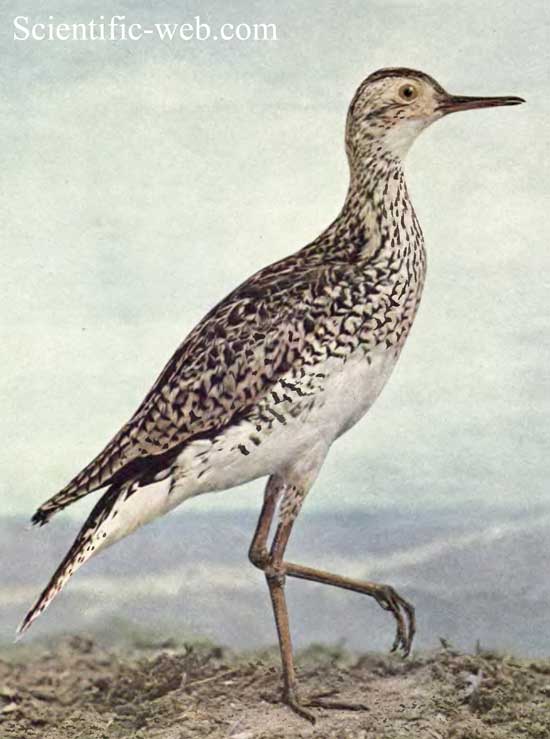
Bartramia longicauda
Superregnum: Eukaryota
Regnum: Animalia
Subregnum: Eumetazoa
Cladus: Bilateria
Cladus: Nephrozoa
Superphylum: Deuterostomia
Phylum: Chordata
Cladus: Craniata
Subphylum: Vertebrata
Infraphylum: Gnathostomata
Superclassis: Tetrapoda
Cladus: Reptiliomorpha
Cladus: Amniota
Classis: Reptilia
Cladus: Eureptilia
Cladus: Romeriida
Subclassis: Diapsida
Cladus: Sauria
Infraclassis: Archosauromorpha
Cladus: Crurotarsi
Divisio: Archosauria
Subsectio: Ornithodira
Subtaxon: Dinosauromorpha
Cladus: Dinosauria
Ordo: Saurischia
Cladus: Theropoda
Cladus: Neotheropoda
Infraclassis: Aves
Cladus: Euavialae
Cladus: Avebrevicauda
Cladus: Pygostylia
Cladus: Ornithothoraces
Cladus: Euornithes
Cladus: Ornithuromorpha
Cladus: Ornithurae
Cladus: Carinatae
Parvclassis: Neornithes
Cohors: Neognathae
Ordo: Charadriiformes
Subordo: Charadrii
Familia: Scolopacidae
Genus: Bartramia
Species: Bartramia longicauda
Name
Bartramia longicauda (Bechstein, 1812)
Synonyms
Tringa longicauda (protonym)
References
Allgemeine Übersicht der Vogel 4 (2): 453, pl.42.
Vernacular names
brezhoneg: Strelleg-Bartram
català: Terrir cuallarg
čeština: Bartramie dlouhoocasá
Cymraeg: Pibydd cynffon-hir
dansk: Bartramsklire
Deutsch: Prärieläufer
Ελληνικά: Μπαρτράμια
English: Upland Sandpiper
Esperanto: Longvosta tringo
español: Correlimos Batitú
eesti: Koovtilder
euskara: Territ cuallarg
suomi: Preeriakahlaaja
føroyskt: Lágarstelkur
français: Maubèche des champs
Gaeilge: Gobadán Sléibhe
galego: Territ cuallarg
Avañe'ẽ: Mbatui ñu
עברית: בצנית זנבתנית
magyar: Hosszúfarkú cankó
íslenska: Sléttulæpa
italiano: Piro-piro codalunga
日本語: マキバシギ
lietuvių: Ilgauodegis tilvikas
Malti: Pluverott ta' Denbu
Nederlands: Bartrams Ruiter
norsk: Præriesnipe
polski: Preriowiec
português do Brasil: Maçarico-do-campo
português: Maçarico-do-campo
русский: Бартрамия
slovenčina: Bartrámia dlhochvostá
slovenščina: Travničar
svenska: Piparsnäppa
Türkçe: Uzun kuyruklu düdükçün
中文: 高原鹬
The upland sandpiper (Bartramia longicauda) is a large sandpiper, closely related to the curlews.[2] Older names are the upland plover and Bartram's sandpiper. In Louisiana, it is also colloquially known as the papabotte.[3] It is the only member of the genus Bartramia. The genus name and the old common name Bartram's sandpiper commemorate the American naturalist William Bartram. The species name longicauda is from Latin longus, "long" and caudus, "tail".[4] The name "Bartram's sandpiper" was made popular by Alexander Wilson, who was taught ornithology and natural history illustration by Bartram.
Description
From Naumann
An adult is roughly 30 cm (12 in) long with a 66 cm (26 in) wingspan. The average weight is 170 g (6 oz). This odd bird has a small dove-like head on a long neck. It is heavily marbled black and brown on the back and wings. The neck is streaked with dark brown which continues down to the breast and on to the flanks. The belly and undertail coverts are white. The tail is quite long for a sandpiper. The upland also sports a white eye-ring and long yellow legs.
Range
They breed from eastern Alaska south east of the Rocky Mountains through Montana to northern Oklahoma and then northeast to Pennsylvania, New England and extreme southern Quebec and Ontario. There are also local breeding populations in northeast Oregon and west central Idaho. They winter in northeastern Argentina, Uruguay and southern Brazil. It is an extremely rare vagrant to the South Pacific, with one record each from Australia and New Zealand.
Habitat
Even though they are sandpipers, they prefer open country with tall grasses to coastal habitat. They are also found at airports, blueberry farms and abandoned strip mines in the east. Their true core range and habitat is in the northern midwest United States.
Behavior and diet
Upland sandpipers forage in fields, picking up food by sight. They are frequently sighted on fence posts and even telephone poles. When an "uppy" alights, it holds its wings up for a few seconds. They are constantly scanning the horizon for intruders. The upland sandpiper's diet includes grasshoppers, crickets, weevils, beetles, moths, ants, flies, bugs, centipedes, millipedes, spiders, snails and earthworms. It also eats some grains and seeds.
Breeding
Bartramia longicauda - MHNT
Upland sandpipers can sometimes be found in small, loose nesting colonies. The breeding season is from early-to-late summer; nests are located on the ground in dense grass. The female lays 4 eggs. Both parents look after the young and may perform distraction displays to lure predators away from the nest or young birds.
Call
Upland sandpipers can be identified by a distinctive call, sometimes called a "wolf whistle", which features a long, ascending whistle followed by a second rising and/or falling call. These sounds are often made while the bird is landing or while flying high.[5]
Conservation
The numbers of these birds increased as forests were cleared in the early 19th century, but declined sharply in the late 19th century due to hunting. They are now regularly present in Midwestern North America but populations are scattered in the east.
Loss of prairie habitat is a concern.[5] Also, livestock grazing has been found to reduce the number of nests in a field.[6] Controlled burns may benefit this species as they feed on low-growing plants that are more easily spotted after a fire.[7]
References
BirdLife International (2016). "Bartramia longicauda". IUCN Red List of Threatened Species. 2016: e.T22693203A93391112. doi:10.2305/IUCN.UK.2016-3.RLTS.T22693203A93391112.en. Retrieved 13 November 2021.
Thomas, Gavin H.; Wills, Matthew A.; Székely, Tamás (August 2004). "A supertree approach to shorebird phylogeny". BMC Evolutionary Biology. 4 (28): 28. doi:10.1186/1471-2148-4-28. PMC 515296. PMID 15329156.
"papabotte". Dictionary of American Regional English. Harvard University Press. Retrieved 12 February 2016.
Jobling, James A (2010). The Helm Dictionary of Scientific Bird Names. London: Christopher Helm. pp. 68, 229. ISBN 978-1-4081-2501-4.
Stucker, Steve (March–April 2008). "Minnesota Profile: Upland Sandpiper" (PDF). Minnesota Conservation Volunteer. Minnesota Department of Natural Resources: 80.
Bowen, Bonnie S.; Kruse, Arnold D. (1993). "Effects of grazing on nesting by upland sandpipers in southcentral North Dakota". Journal of Wildlife Management. Jamestown, ND: Northern Prairie Wildlife Research Center Online. 57 (2): 291–301. doi:10.2307/3809426. JSTOR 3809426.
"Fall 2010 Update". Prairies to Pines: News from Minnesota, North Dakota, and South Dakota. The Nature Conservancy.
Retrieved from "http://en.wikipedia.org/"
All text is available under the terms of the GNU Free Documentation License

